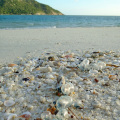
©Anne Hoggett: Physalia utriculus with two species of fish sheltering underneath it at Lizard Island. The long tentacle has broken after making contact with a snorkeller.
Colours
Distinguishing features
A bluebottle appears to be an individual animal but it is actually a colony comprising numerous specialised individuals. The colony has a distinctive blue gas-filled float with a crest along the anterior half and an uncrested, tapering posterior end. There is a single main tentacle equipped with stinging cells called nematocysts, and often several much shorter tentacles. At Lizard Island, most colonies are quite small with float length in the range 10 to 60 mm. The main tentacle can be several meters long and it can retract to just a few centimetres.
The name Physalia utriculus is currently regarded as unaccepted and only a single species (Physalia physalis) is recognised in the genus (WORMS accessed 28 Aug 2019). However, discussion on iNaturalist (link below) suggests that was a bad move and that the common Australian form should retain the name Physalia utriculus. Here we follow the view of Dr Phil Alderslade (@doctocoral on iNat).
Size
- Averaging 8 cm (float length)
Synonyms
Distribution
Local abundance
- Lizard Island, Queensland, Australia: This is the most common bluebottle in Australia. The species is absent from Lizard Island waters for most of the year but it can be abundant at times, often in summer and associated with northwesterly winds.
Web resources
Danger
- significant discomfort - Causes immediate, painful stings on contact.
References
- Anonymous (2004). Stinging jellyfish in tropical Australia: bluebottles and Pacific Man-o-War, CRC Reef Research Centre, Current State of Knowledge.




